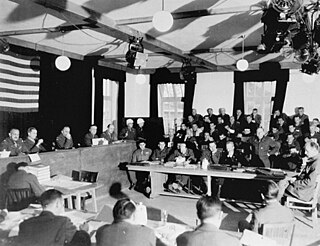
Mauthausen was a German Nazi concentration camp on a hill above the market town of Mauthausen, Upper Austria. It was the main camp of a group with nearly 100 further subcamps located throughout Austria and southern Germany. The three Gusen concentration camps in and around the village of St. Georgen/Gusen, just a few kilometres from Mauthausen, held a significant proportion of prisoners within the camp complex, at times exceeding the number of prisoners at the Mauthausen main camp.

German Earth and Stone Works was an SS-owned company created to procure and manufacture building materials for state construction projects in Nazi Germany. DEST was a subsidiary company of Amtsgruppe W of SS Main Economic and Administrative Office (WVHA). Both Amt. W and the WVHA were headed by Waffen-SS generals Oswald Pohl and Georg Lörner.

The Dachau trials, also known as the Dachau Military Tribunal, handled the prosecution of almost every war criminal captured in the U.S. military zones in Allied-occupied Germany and in Allied-occupied Austria, and the prosecutions of military personnel and civilian persons who committed war crimes against the American military and American citizens. The war-crime trials were held within the compound of the former Dachau concentration camp by military tribunals authorized by the Judge Advocate General of the U.S. Third Army.

Sankt Georgen an der Gusen is a small market town in Upper Austria, Austria, between the municipalities of Luftenberg and Langenstein. As of 2015, the town had 3,779 inhabitants.
The Mauthausen-Gusen camp trials were a set of trials of SS concentration camp personnel following World War II, heard by an American military government court at Dachau. Between March 29 and May 13, 1946, and then from August 6 to August 21, 1947, a total of 69 former camp personnel were tried. Among them were some of the former guards at the Mauthausen-Gusen concentration camp system and August Eigruber, a former Gauleiter of Upper Austria.
Vincenzo Pappalettera was an Italian writer and historian, notable for his firsthand account of his imprisonment in the Mauthausen-Gusen concentration camp during the Second World War.

Otakar Batlička was a Czech adventurer, journalist, ham (amateur) radio operator, and member of the Czech-based Nazi resistance group Obrana Národa during World War II.

Johann Gruber, also known as "Papa Gruber" and "The Saint of Gusen", was an Austrian Roman Catholic priest who was imprisoned in Concentration Camp Gusen I from 1940 until he was murdered by the camp commandant on Holy Friday 1944. In the concentration camp, Gruber helped many others survive by raising funds from outside the camp and bribing the SS men and kapos in order to organise the delivery of food to starving inmates.

Père (Father) Jacques de Jésus, OCD, was a French Roman Catholic priest and Discalced Carmelite friar. While serving as headmaster of a boarding school run by his order, he took in several Jewish refugees to protect them from the Nazi government of occupation, for which he was arrested and imprisoned in various concentration camps.
The Austrian SS was that portion of the Schutzstaffel (SS) membership from Austria. The term and title was used unofficially. They were never officially recognized as a separate branch of the SS. Austrian SS members were seen as regular personnel and they served in every branch of the SS.

Karl Chmielewski was a German SS officer and concentration camp commandant. Such was his cruelty, he was dubbed Teufel von Gusen or the Devil of Gusen.

The Reichsgau Upper Danube was an administrative division of Nazi Germany, created after the Anschluss in 1938 and dissolved in 1945. It consisted of what is today Upper Austria, parts of Southern Bohemia, and a small part of the Salzkammergut which was annexed from Styria.
Rudolf Anton Haunschmied is an Austrian author and local historian.

Hans Maršálek was an Austrian typesetter, political activist, detective, historian, and suspected spy for the Soviet Union. A devout socialist and active in the resistance, he was arrested by the Nazis and imprisoned in the Mauthausen concentration camp. After the war, he joined the Austrian political police and was instrumental in tracking down and convicting numerous Nazi criminals. He also became the main chronicler of the camp's history, helped establish the Mauthausen Memorial Museum, and published several books.
The Austrian Mauthausen Committee is responsible for scientific and educational work concerning the Mauthausen-Gusen concentration camp and its satellite camps in Austria. This association was founded in 1997 and is the subsequent organisation of the Austrian Concentration Camp Community Mauthausen.
Albert Sauer was a Nazi German commandant of Mauthausen-Gusen concentration camp. He died of wounds in 1945, and was never tried for his role in The Holocaust.

Granitwerke Mauthausen was one of the names used by the DEST company for its branch based in Sankt Georgen an der Gusen and which exploited the slave manpower confined in certain subcamps of the Mauthausen-Gusen concentration camp system: Gusen I, Gusen II, Gusen III, and Mauthausen.
Aleksei Nikolayevich Kostylev was a Soviet Russian football player and coach.

Gusen was a subcamp of Mauthausen concentration camp operated by the SS between the villages of Sankt Georgen an der Gusen and Langestein in the Reichsgau Ostmark. Primarily populated by Polish prisoners, there were also large numbers of Spanish Republicans, Soviet citizens, and Italians. Initially, prisoners worked in nearby quarries, producing granite which was sold by the SS company DEST.











